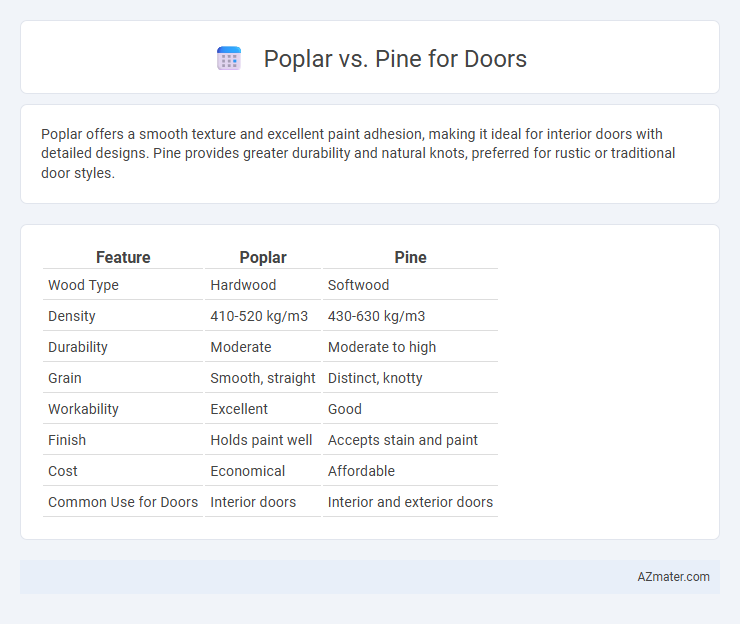Poplar offers a smooth texture and excellent paint adhesion, making it ideal for interior doors with detailed designs. Pine provides greater durability and natural knots, preferred for rustic or traditional door styles.
Table of Comparison
| Feature | Poplar | Pine |
|---|---|---|
| Wood Type | Hardwood | Softwood |
| Density | 410-520 kg/m3 | 430-630 kg/m3 |
| Durability | Moderate | Moderate to high |
| Grain | Smooth, straight | Distinct, knotty |
| Workability | Excellent | Good |
| Finish | Holds paint well | Accepts stain and paint |
| Cost | Economical | Affordable |
| Common Use for Doors | Interior doors | Interior and exterior doors |
Introduction: Poplar vs Pine for Doors
Poplar and pine are commonly used woods for doors, each offering distinct characteristics that influence durability and appearance. Poplar is known for its smooth grain and resistance to warping, making it ideal for painted finishes, while pine is valued for its natural knots and warm tones, often preferred for rustic or traditional styles. Choosing between poplar and pine depends on the desired aesthetic, durability requirements, and budget considerations.
Wood Characteristics: Poplar vs Pine
Poplar wood is known for its consistent, smooth texture and light color, making it an excellent choice for door projects needing a fine finish and easy paint adhesion. Pine, on the other hand, has a more pronounced grain pattern and natural resin content that gives it a warmer appearance but may require more maintenance to prevent warping or discoloration over time. Both woods offer moderate hardness, with poplar being slightly more resistant to dents and pine providing a rustic aesthetic favored in traditional door designs.
Durability and Strength Comparison
Poplar wood, known for its moderate durability and softer texture, is less resistant to dents and decay compared to pine, which offers higher strength and better resilience in door applications. Pine's dense grain structure contributes to greater durability, making it ideal for exterior doors exposed to varying weather conditions. Despite poplar's smooth finish and ease of painting, pine remains the preferred choice for strength and long-lasting door performance.
Appearance and Grain Differences
Poplar doors typically exhibit a light, creamy color with subtle green or brown undertones, featuring a straightforward and uniform grain that creates a smooth, consistent surface ideal for painting. Pine doors display a warmer yellow to amber hue with more prominent knots and a pronounced grain pattern, offering a rustic and natural look that highlights the wood's organic texture. Pine's distinct grain and knotty character contrast with poplar's finer, less conspicuous grain, making poplar a preferred choice for sleek, modern finishes and pine better suited for traditional, country-style aesthetics.
Workability and Machinability
Poplar offers excellent workability due to its fine, even texture and softer nature, making it easy to cut, shape, and sand for door construction. Pine, while slightly harder, provides good machinability with less tendency to chip or splinter, allowing precise cuts and smooth finishes. Both woods are popular for doors, but Poplar is preferred for intricate designs due to its superior ease of handling in detailed machining.
Cost and Availability
Poplar doors offer a cost-effective option due to the wood's widespread availability and rapid growth, making it generally less expensive than pine. Pine is also readily accessible but can vary in price based on resin content and grade, sometimes costing more than poplar in certain regions. Both woods are commonly found in lumber markets, but poplar's consistent supply often leads to lower overall door manufacturing costs.
Paint and Stain Compatibility
Poplar wood offers excellent paint adhesion due to its smooth grain and uniform texture, making it ideal for colorful door finishes, while pine absorbs stain unevenly because of its resinous knots and coarse grain, often resulting in blotchy appearances. When staining pine doors, pre-conditioning with a wood conditioner is essential to prevent blotching and achieve a more consistent finish, whereas poplar's dense fibers allow for a more predictable staining outcome. Both woods respond well to primers before painting, but poplar provides a superior base for vibrant and durable paint colors compared to pine.
Popular Uses in Door Manufacturing
Poplar is widely used in door manufacturing for interior doors due to its smooth grain, ease of painting, and affordability, making it ideal for primed or painted finishes. Pine, favored for its natural knots and warm tones, is commonly selected for rustic or country-style doors, offering durability and a cost-effective option for both interior and exterior applications. Both woods provide versatility, but poplar's uniform texture excels in modern, painted door designs, while pine suits traditional, stained door styles.
Environmental Impact and Sustainability
Poplar wood is highly regarded for its fast growth rate and renewable qualities, making it a more sustainable choice compared to pine. Pine, while abundant, often requires longer growth periods and can come from plantations that contribute to deforestation. The lower carbon footprint of poplar due to its rapid growth and better regeneration capacity supports eco-friendly door manufacturing.
Final Verdict: Which Wood is Better for Doors?
Poplar offers a smooth finish and is easier to paint, making it ideal for interior doors where cost-effectiveness and paintability are priorities. Pine provides greater durability and natural grain beauty, suitable for both interior and exterior doors due to its strength and resistance to wear. Choosing between poplar and pine depends on whether you prioritize aesthetics and sturdiness (pine) or affordability and ease of finishing (poplar) for your door project.

Infographic: Poplar vs Pine for Door
 azmater.com
azmater.com